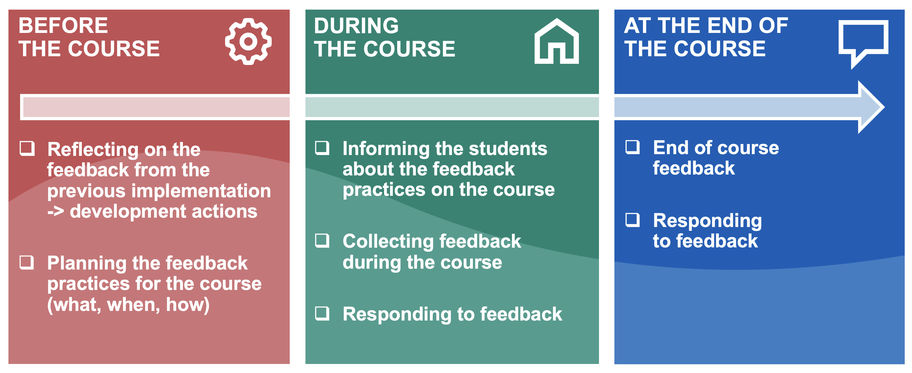Course feedback as a course element
Course feedback as a course element
Student feedback is an important part of an inclusive teaching and learning culture at Aalto University, and it is supported by the following principles: feedback is interactive, impactfull and streamlined. With these principles Aalto hopes to support the development of an open feedback culture. It means that feedback is constructively and easily given and actively discussed and utilised to promote interaction and development of teaching and learning.

Collecting feedback can be seen as a course element that is planned in a similar manner as e.g., assessment on a course. The planning can focus around three phases: what happens before the course, during the course and at the end of the course. More detailed information on the automated timing of the course feedback system can be found here.
When planning the course it is beneficial to take a look back at the previous feedback and reflect on the development needs of the course.
Also, the feedback practices for the course are planned: What kind of topics would give useful information during the course? What could be left for the end-of-course feedback survey?
In a nutshell:
- Have a look at the feedback from the previous implementation, if possible, and make adjustments according to need and your own consideration. You can find your course feedback in PowerBI. If the adjustments have already been planned and implemented after the previous course implementation, you can focus on steps 2 and 3.
- Plan the feedback practices for the course: formulate the questions for the mid-course feedback survey(s) and the end-of-course feedback survey. You can use the course feedback tool in MyCourses to collect feedback. You can find the practical steps for getting started with the surveys here.
- Reserve time in your course schedule to inform your students about your feedback practices and to collect feedback. This is likely to result in a higher response rate.
It is important to inform students about the previous feedback and the development actions based on the feedback. Sometimes it means justifying the choices made, explaining the choices to the students and sticking to them. In the beginning of the course it is also good to inform the students about how and why feedback will be collected during the course.
The course feedback tool in MyCourses is an excellent way to collect mid-course feedback. An informal feedback discussion is also a great way to get feedback. During the course, it makes sense to choose topics that help support students during the course, while more holistic questions aiming at course development can be included in the survey at the end of the course.
Feedback received from students leads to giving a response. That can be done for example orally in the beginning of a lecture, addressing some of the most important observations.
In a nutshell:
- Inform your students about the feedback practices: when and how.
- Reserve time for collecting feedback and promoting it.
- Respond to the feedback you get during the course.
At the end of the course the fully automated feedback system sends the end-of-course feedback survey to the students. The teacher can add their own questions to this feedback survey, too. The survey is open to the students before the course ends, and you can have a look at the preliminary report as soon as there are five or more responses. You can discuss and comment on the feedback given already during the last lecture(s). This reminds and motivates other students to give feedback too.
Reflect on the feedback given in order to develop your course and yourself as a teacher. Respond to final feedback after the course end. That can be easily done in the course feedback tool in MyCourses. This is rewarding to the students, and it strengthens the feedback culture at Aalto.
Course feedback tool now in MyCourses
Check out course feedback in MyCourses. You can add questions to the end-of-course surveys up to a month before the course start in the course feedback tool in MyCourses. You can also plan and time mid-course surveys for your course.
Course feedback support
Contact course feedback support if you need any help.
Contact details
Course feedback in Aalto University
Course feedback is a unique part of the feedback portfolio in Aalto University and it reaches students in all phases of their studies and is collected systematically throughout Aalto. Hearing the voice of students is vital for the development of teaching and education as well as for quality assurance and for improving study-related services. The course feedback tool can be found in MyCourses. Feedback is used on multiple levels in many ways and its utilisation is a special focus area at Aalto.

Main page for instructions of course feedback tool
At Aalto University, course feedback is collected from almost all courses. On these pages you will find teacher's instructions for using the course feedback tool on MyCourses.

Course feedback questions
At Aalto University, we categorize the end-of-course feedback questions into three types: common Aalto questions, school-specific questions, and course-specific questions. In 2025, Aalto and school-specific questions were significantly revised. This page provides a comprehensive collection of all updated Aalto and school-specific questions that have been in use from the start of the 2025–2026 academic year.
Additionally, you'll find information about course-specific questions and the question library, along with tips for crafting effective feedback questions and guidelines for revising existing Aalto and school-specific questions.

Making use of course feedback and reports
Aalto University pays special attention to the use of course feedback. With a view to achieving a broad impact, course feedback is used for various purposes: it is a tool not only for developing courses and teaching, but also for assessing teachers’ performance in MyDialogues and for other strategic and pedagogical development. Reports play a key role in this type of multi-level development work. In addition to the comprehensive reports designed specifically for teachers and leadership, all Aalto University employees have access to a summary of the student responses to the Aalto questions in the course feedback survey. This page contains information on how to make use of course feedback and the reports available. For instructions on how to process course feedback, see the bottom of the page.









